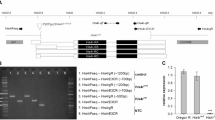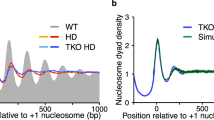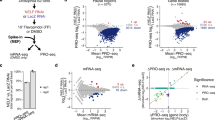Abstract
Nuclease-hypersensitive sites in chromatin exist at the 5′ side of many eukaryotic genes. To gain some understanding of the molecular basis of these hypersensitive sites, we have now examined the pair of sites upstream of the Drosophila hsp70 gene in a series of plasmids that contain deletions in the hypersensitive region and have been transformed into yeast cells. Hypersensitive sites 5′ to a Drosophila hsp70 gene are preserved when this gene is introduced into yeast by transformation1. We find that a yeast strain containing a plasmid in which the deletion extends through the first hypersensitive site still displays the normal pair of hypersensitive sites, so DNA sequences over which the first hypersensitive site is centred are not required for hypersensitivity at this position and the site can form over a foreign DNA sequence juxtaposed against this deletion end point. Deletions progressing further into the region bracketed by the pair of 5′ hypersensitive sites eliminate the first hypersensitive site and alter the downstream site. We propose that the hypersensitive sites are generated through the binding of a protein that renders flanking sequences more accessible to nucleases, perhaps by preventing normal chromatin packaging.
This is a preview of subscription content, access via your institution
Access options
Subscribe to this journal
Receive 51 print issues and online access
$199.00 per year
only $3.90 per issue
Buy this article
- Purchase on Springer Link
- Instant access to full article PDF
Prices may be subject to local taxes which are calculated during checkout
Similar content being viewed by others
References
Costlow, N. A. & Lis, J. T. Molec. cell. Biol. 4, 1853–1863 (1984)
Lis, J. T., Simon, J. A. & Sutton, C. A. Cell 35, 403–411 (1983).
Wu, C. Nature 309, 229–234 (1984).
O'Hare, K. & Rubin, G. M. Cell 34, 25–35 (1983).
Jongstra, J. et al. Nature 307, 708–714 (1984).
Groudine, M. & Weintraub, H. Cell 30, 131–139 (1984).
Emerson, B. M. & Felsenfeld, G. Proc. natn. Acad. Sci. U.S.A. 81, 95–99 (1984).
Parker, C. & Topol, J. Cell 37, 273–283 (1984).
Pelham, H. R. B. Cell 30, 517–528 (1982).
Lis, J. et al. Heat Shock from Bacteria to Man (eds Schlesinger, M. J., Ashburner, M. & Tissières, A.) 57–62 (Cold Spring Harbor Laboratory, New York, 1982).
Clarke, L. & Carbon, J. Nature 287, 504–509 (1980).
Gray, H. B., Ostrander, D. A., Hodnett, J. L., Legerski, R. J. & Robberson, D. L. Nucleic Acids Res. 2, 1459–1492 (1975).
Author information
Authors and Affiliations
Rights and permissions
About this article
Cite this article
Costlow, N., Simon, J. & Lis, J. A hypersensitive site in hsp70 chromatin requires adjacent not internal DNA sequence. Nature 313, 147–149 (1985). https://doi.org/10.1038/313147a0
Received:
Accepted:
Issue Date:
DOI: https://doi.org/10.1038/313147a0
This article is cited by
-
DNase I hypersensitive sites in the 5′-region of the maize Shrunken gene in nuclei from different organs
Molecular and General Genetics MGG (1988)
-
An exonuclease protection assay reveals heat-shock element and TATA box DNA-binding proteins in crude nuclear extracts
Nature (1985)
Comments
By submitting a comment you agree to abide by our Terms and Community Guidelines. If you find something abusive or that does not comply with our terms or guidelines please flag it as inappropriate.



